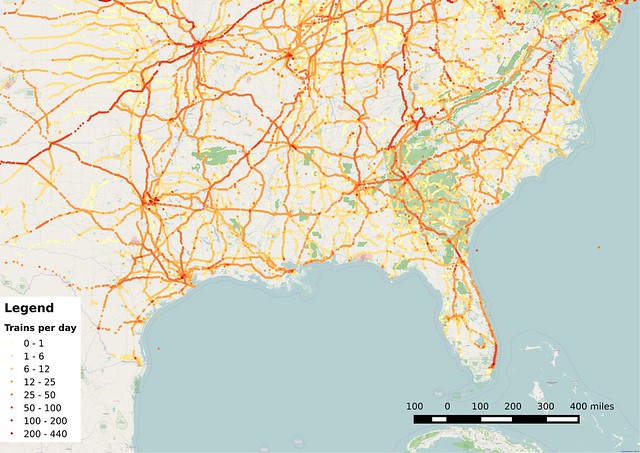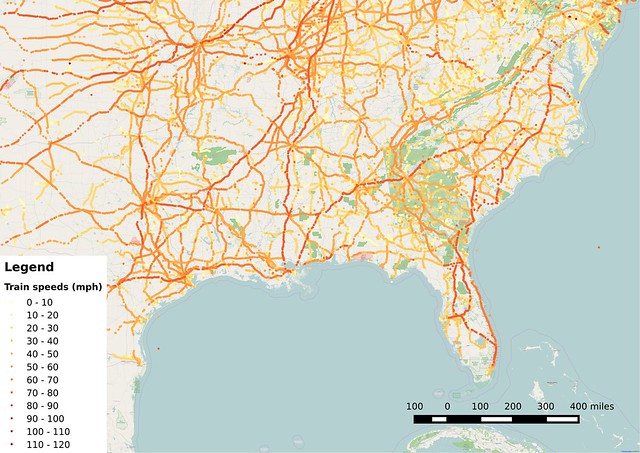The meeting announcement has led me to dig into the route and do some analysis of my own, though this doesn't necessarily reflect what will be presented by the St. Croix Valley Rail Group on Wednesday.
MnDOT's plan suggested a regional rail service operating approximately four round-trips through the day, though presumably they would be spread out, making it unlike peak-only commuter rail service. (Commuter rail had been studied and discarded on this route as part of the Gateway Corridor study, which is instead looking at bus rapid transit for the much shorter Gold Line route).
Wisconsin's Department of Transportation had also been working on a 20-year rail plan around the same time as Minnesota, though it was put on pause following the Tea Party-infused political surge later that year which put Governor Scott Walker in office alongside a much more conservative legislature in the winter of 2010–2011.
Wisconsin then ended up with a near-total abandonment of passenger rail planning. The official state rail plan document was finally approved last year, and includes possible links to Eau Claire, Madison (where federal funding was famously turned down by the state), and Green Bay.
That's good, but a bit underwhelming, considering how Wisconsin's population is less heavily concentrated than Minnesota's (see this map of cities with populations greater than 5,000 and contrast it to the one for Minnesota), so I expected a couple of other interesting links. These seem to be cribbed from older Midwest Regional Rail Initiative plans, a multi-state effort for high(er)-speed rail that was once led by Wisconsin.
 |
| Wisconsin's rail plan for the year 2030 includes possible connections to Eau Claire, Madison, and Green Bay. |
But for this post, I want to focus on Eau Claire, which lies about 100 miles east of Minneapolis. The city itself only has a population of about 65,000, though there are a number of nearby towns including Chippewa Falls which creates a small metro area of about 165,000 people. Menomonie is also close by, and the Eau Claire-Chippewa Falls-Menomonie Combined Metropolitan Statistical Area now reaches a population of almost 210,000.
Eau Claire and Menomonie (at nearby Menomonie Junction) had rail service on the Chicago & North Western Railway's Twin Cities "400" until July 23, 1963, about 8 years before the introduction of Amtrak. A timetable from 1962 listed travel time at 114 to 120 minutes from Minneapolis to Eau Claire and 85 to 90 minutes from St. Paul to Eau Claire (the eastbound train was slightly faster, at least on paper).
This was one of the three fastest trains to run between the Twin Cities and Chicago, although it had the major flaw that it only ran once per day per direction. That made it very hard to compete with automobile and air travel. Even today, Eau Claire has two daily round-trip flights to Chicago, subsidized through the Essential Air Service program (though they will still cost you more than $350 round-trip).
Restoring passenger rail service on the corridor has the potential to provide a more frequent transportation option for the area's population while also reducing costs, especially compared to flying: The existing Eau Claire air service costs close to 70 cents per mile when EAS funding is included, while the average cost for Amtrak to carry a passenger one mile is about 40 cents (also including their subsidy).
It's certainly a bit tough to imagine reestablishing service that was abandoned by the railroads more than 50 years ago now, though it's important to note that Wisconsin's population has grown by 40% since 1963, and Minnesota's has grown by 55%. Even if the potential market for rail service remains relatively small, it continues to grow year over year.
So, what are the challenges facing restoration of service on this line? Here's a map I put together of single-tracking and sidings along the corridor, to give an idea of the route's capacity:
Between Saint Paul and Eau Claire, there are only four places with long sidings or segments of double-tracking, plus another short siding at Menomonie Junction, which limits how often trains can pass each other. It's 38 miles between the double-tracked segment in Hudson eastward to Menomonie, according to Google Maps' "Satellite" view, and about 46 miles from Hudson to the longer siding near Elk Mound. [Update: It turns out that I missed a siding between Woodville and Hersey, which reduces the longest stretch of single-tracking to 21 miles.]
MnDOT's rail plan only suggested running four round-trips per day (eight total trains), and the Federal Railroad Administration's Highway-Rail Crossing Inventory suggests that there are only about four freight trains per day, so with appropriate scheduling, it's conceivable that 12 daily trains (less than one per hour) could operate over that gap without needing any new infrastructure. Still, it would be better to add a few new sidings to shorten the gap. Even with upgraded track speeds, passenger trains could take half an hour to 45 minutes to cover the gap, and freights could take more than an hour, potentially leading to serious delays on trips that should only take two hours end-to-end.
A few additional sidings would be a good idea, likely including one near Baldwin to be about halfway along the line. There are also clusters of freight customers near Menomonie and Truax which should have their spurs connected to shared sidings. That would allow the main track to be kept clear for through traffic while freight crews deal with the relatively slow process of attaching and detaching rail cars at the customer sites.
Much more of the line used to have double-track and sidings, but it was pulled out over the decades as freight traffic consolidated onto fewer routes and the need to keep extra track for passenger service disappeared. This means that there are few physical obstacles to restoring it, but it will cost a considerable amount of money. Each siding would likely cost several million dollars.
The tracks have also been allowed to degrade over the years, so the allowed train speeds are not as high as they once were. Freight trains can reach a maximum of 50 mph on the route, but only for a few short segments, according to a 2007 Union Pacific timetable I scraped off the Internet a few years ago. 85% of the route was limited to 30 mph or less at that time, though things may have changed since then.
The timetable notes that passenger trains are allowed to go 10 mph faster than freights on the line, but that doesn't help much when comparing it to the nearby Interstate 94 which has recently been updated with 70 mph speed limits (increasing from a rural freeway limit of 65 mph that Wisconsin had for many years).
Restoring tracks to 79 mph service, the typical standard for passenger service in the U.S., or beyond into "high-speed" territory will require an investment of a few hundred thousand dollars per mile. This type of work involves removing worn-out ties/sleepers, refreshing track ballast, and smoothing and straightening the rails themselves. Depending on the age and quality of the rails, they may only need to be run through a grinding machine to restore a good running surface, but bad segments would obviously need to be replaced.
The line is in relatively good shape as far as signaling goes, but would still need to be significantly improved for passenger trains to run on the route. The line has automatic block signaling (ABS) in place for all but about six miles of track, but future passenger lines are required to have positive train control (PTC). It's unclear how much that would need to cost, since it is still a new technology and price estimates have fluctuated wildly over the past few years.
That's a major hurdle, though the freight company may be required to implement it anyway if it carries hazardous materials on the route. If that's the case, then adding passenger service back on the route would be beneficial to the railroad, since the costs could be shared between the freight and passenger operations (with passenger trains most likely being funded by state and local governments, though the possibility of a privately-funded operation probably shouldn't be discarded entirely).
If the line is extended beyond Eau Claire as shown in the Wisconsin Rail Plan map above, the challenges would be similar for the next 120 miles of track. However, the last nine miles between Wyeville and Camp Douglas (where the line could merge with today's route of the Empire Builder) deserves special note: That section of track appears to be disused and in danger of abandonment. Google's aerial images show the right-of-way in a condition of poor repair, and miles of underused rail cars were parked there for long-term storage when pictures were taken.
That's yet another reason why planning of passenger service to or through Eau Claire needs to get going right away, before those tracks disappear.
The St. Croix Valley Rail Group is planning two presentations for Wednesday, September 23rd. I haven't had any direct contact with the group, but thought the timing presented a good opportunity to do some of my own digging. The meetings are scheduled at 5:30 and 7:00 pm, respectively:
River Falls Public Library
140 Union St
River Falls, WI
5:30 pm
Hudson House Grand Hotel
1616 Crest View Drive
Hudson, WI
7:00 pm

